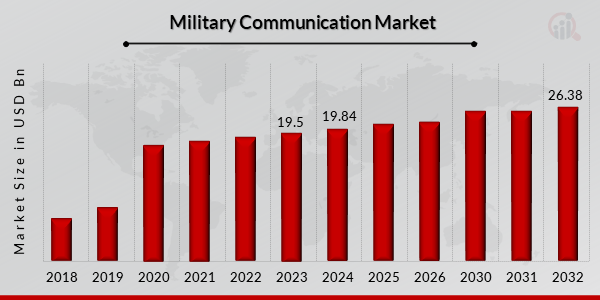Military Communication Market Overview: Key Drivers and Strategic Outlook

Military Communication Market Introduction
The global military communication market has become a cornerstone of modern defense strategies, ensuring secure, fast, and efficient communication in increasingly complex and dynamic environments. According to a recent report by Market Research Future, the market was valued at USD 19.5 billion in 2023 and is projected to grow to USD 26.38 billion by 2032, registering a compound annual growth rate (CAGR) of 3.63% over the forecast period (2024–2032).
As nations worldwide adapt to evolving threats, ranging from cyberattacks to hybrid warfare, the need for robust communication infrastructures is more critical than ever. This article explores the key growth drivers, emerging trends, and outlook of the military communication market
Key Market Drivers
- Increased Defense Spending
Rising global defense budgets have been a significant catalyst for growth in military communication systems. Countries like the United States, China, India, and members of NATO are allocating larger portions of their defense expenditure to modernize their communication infrastructure. This investment is critical to maintain strategic superiority, enhance operational efficiency, and ensure the safety of deployed forces.
- Geopolitical Tensions and Security Concerns
The geopolitical landscape continues to be volatile, marked by territorial disputes, terrorism, cyber warfare, and great power competition. These factors are driving governments to upgrade their command, control, communications, computers, intelligence, surveillance, and reconnaissance (C4ISR) capabilities. Reliable communication systems are essential for real-time decision-making, battlefield coordination, and situational awareness.
- Technological Advancements and Digital Transformation
Modern military operations rely heavily on cutting-edge technologies such as satellite communications, software-defined radios, 5G networks, and AI-powered communication tools. These technologies allow for enhanced data transfer, greater encryption, interoperability among forces, and seamless integration with unmanned systems. As digital transformation accelerates, military forces are increasingly adopting smart, scalable, and secure communication solutions.
Key Segments and Application Areas
The military communication market is segmented by platform (airborne, naval, ground), communication type (satellite, radio, data link, etc.), and end-user (land forces, naval forces, air forces). Among these, satellite communication (SATCOM) is gaining traction for its ability to enable long-range and beyond-line-of-sight communications, especially in remote and hostile environments.
Additionally, ground-based communication systems remain vital for tactical command and control on the battlefield, while airborne and naval platforms are increasingly integrating advanced systems to support multi-domain operations.
Get a Quote - Request a price quote for the report or specific research services.
Emerging application areas include:
- Network-Centric Warfare: Leveraging high-speed data networks to connect various military assets for real-time data sharing.
- Cyber-Resilient Systems: Designing communication infrastructure that can withstand sophisticated cyber threats.
- Unmanned Systems Communication: Supporting drones, UGVs (Unmanned Ground Vehicles), and UUVs (Unmanned Underwater Vehicles) with secure and efficient data links.
Regional Outlook
- North America leads the market due to significant investment by the U.S. Department of Defense in next-generation communication technologies.
- Europe is witnessing growing demand, driven by NATO’s modernization programs and heightened tensions in Eastern Europe.
- Asia-Pacific is a rapidly growing region, with countries like China, India, Japan, and South Korea enhancing their defense capabilities amid regional disputes and rising security concerns.
These regions are expected to play pivotal roles in shaping the market landscape over the next decade.
Challenges and Opportunities
While the outlook remains positive, the military communication market does face several challenges:
- Cybersecurity threats continue to evolve, requiring constant upgrades and threat mitigation strategies.
- Interoperability issues between legacy systems and new technologies can hinder seamless communication.
- Budget constraints in developing economies may limit adoption of high-end solutions.
However, these challenges also open up new opportunities for innovation. For instance, companies offering modular, scalable, and cost-effective communication platforms are well-positioned to address the diverse needs of global militaries. Public-private partnerships and defense-tech collaborations are also creating fertile ground for cutting-edge R&D.
Future Outlook
Looking ahead, the military communication market is set to benefit from the continued integration of AI, machine learning, quantum communication, and edge computing. These technologies will further enhance the speed, reliability, and security of communications, enabling faster decision-making and improved mission outcomes.
As warfare becomes more data-centric and autonomous systems gain prominence, the demand for advanced, secure, and real-time communication capabilities will only grow stronger.
Conclusion
The military communication market is entering a transformative era, driven by technological innovation, increased defense spending, and rising global security concerns. With a projected CAGR of 3.63% through 2032, the market presents significant opportunities for defense contractors, communication technology providers, and policymakers focused on national security infrastructure.
Nations that invest in modern, integrated communication systems will be better equipped to respond to current threats and adapt to the complex challenges of future warfare.
- Art
- Causes
- Crafts
- Dance
- Drinks
- Film
- Fitness
- Food
- Games
- Gardening
- Health
- Home
- Literature
- Music
- Networking
- Other
- Party
- Religion
- Shopping
- Sports
- Theater
- Wellness


